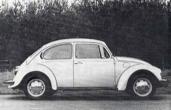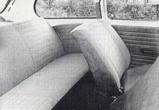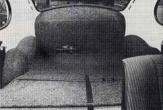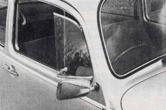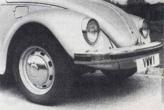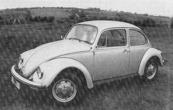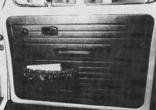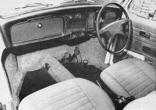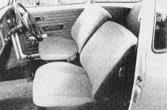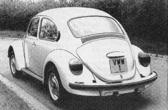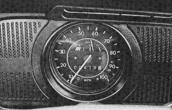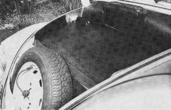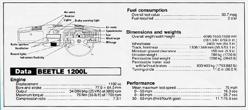
Old Faithful (September 1986)
This is not a reprint from an old magazine, nor is it a report on a reader's car.
This is a new test of an almost brand new Beetle which is one of the final batch of rhd UK-specification Beetles produced in Germany in 1977, since when it has been preserved in as-new condition and has covered less than 500 miles.
This car, which has been given the registration number VWW 1 is being kept at Audi Volkswagen's headquarters in Milton Keynes, mainly for display purposes, coming out on special occasions such as Motor 100, the Beetle's 50th anniversary celebrations and VW ACTION.
We are privileged to have been allowed to have this unique vehicle for road test.
The final batch of rhd Beetles consisted of 650 cars, all 1200L models, produced at Emden at the end of 1977. They were sold in Britain during the early part of 1978 for £2626.
VWW 1 has diamond silver metallic paintwork with blue cloth seats. The car is absolutely original and standard apart from a new Hoppecke battery fitted in 1985. The paintwork looks really superb, having lost none of its gloss in nine years, and it could easily pass as a brand new car.
Having driven about 200,000 miles in Beetles (prior to 1975) I felt quite at home in VWW 1. Features such as the single-dial fascia, the all-or-nothing heater, the pneumatic screenwasher, the opening 'vent wings' (quarter lights) with their clever anti-theft catches, and the bonnet release lever inside the glovebox were perfectly familiar. When I owned a Beetle I would not have commented on the lack of head restraints, non-dipping mirror, absence of delay wipe, or the limited luggage space.
The 1200L specification of 1977 does include some luxury features, notably a padded fascia, fresh air ventilation, reclining seats, luggage compartment cover, heated rear window, reversing lights and chrome hubcaps.
The two-speed fan, together with 'adjustable mixing vents' on the fascia (making an air-blending system) provides a very acceptable standard of ventilation. The heater is extremely powerful, delivering a strong blast of hot air very quickly after starting up. A rare luxury, even today, are the rear outlets. The heated rear window has an obscure little switch underneath the fascia with a warning light in the speedometer dial.
The gearchange is still one of the best to be found in any car, and switches all have a precision-engineered feel. The four-spoked steering wheel (quite trendy in 1977) has a thin, shiny rim and its diameter of 400 mm seems to extend across half the width of the car. There is not much soundproofing and, for an 'L' model, the floor covering seems rather sparse. A thin felt-like carpet covers the sides of the footwells and the sills but there is nothing between the rubber mats and metal floorpan.
Legroom in front is adequate for a tall driver and I found the Beetle more comfortable than some modern cars. In the back, however, it seems no more than in a Scirocco, yet we always regarded Beetles as full four (or even five) seaters.
Equipped with 155 SR15 Goodyear Grand Prix S tyres on 4.5 x 15 wheels, the 1200L feels quite secure on the road. One is not encouraged to corner as fast as a modern fwd VW or Audi, however. Straight ahead the worm and roller steering is a little vague compared to modern rack and pinion systems but it is positive and precise when cornering.
Inevitably the Beetle is affected by cross winds, this being one of its most-publicised weaknesses. On the other hand it is not affected by rough roads, which is one of its well-known strong points. The torsion bar suspension gives a remarkably smooth ride over potholes and ridges and the all-drum brakes work well enough.
Excellent lighting is provided by the Bosch head lamps, fed by a 55 amp alternator. This is one aspect which has really transformed the Beetle since its early days.
The 1192 cc flat four air-cooled engine is, of course, unchanged in power output since 1960, with a maximum of 34 bhp at only 3800 rpm. Maximum torque is 76 Nm at 1700 rpm. The carburettor is a Solex 30 PICT-3 and, with a compression ratio of 7 - 3, the 1200 can operate on 87 octane petrol, which is sub two-star.
Weight is 780 kg, which is heavier than a Polo but lighter than a Golf. In external dimensions the Beetle is 4 in. longer than a Golf, 3 in. higher and 5 in. narrower. In view of the car's low mileage and its special value I did not put it through a rigorous performance test, but recorded sufficient acceleration times to put performance into perspective with current models.
With only 34 bhp and the aerodynamic ideas of 50 years ago, one expects a Beetle to be significantly slower than a Golf or Polo. In fact, it requires 25.7 sec to accelerate from 0 to 60mph, and in third gear it takes 11.7 sec from 30 to 50, so it is a great deal slower than either a Polo C or a Golf diesel. Maximum usable speeds in the gears are only about 20 mph in first, 32 in second and 55 in third, so even accelerating to 40 mph, which takes just over 10 sec, requires two gear changes.
Official top speed is 72 mph but, as any Beetle enthusiast will tell you, this was also quoted as the cruising speed and all Beetles will go faster than their official maximum, given time and perhaps a little help from a favourable wind or gradient.
A following wind or downslope will enable you to build up to maybe 15 mph more than the 'maximum'. But a head wind or upslope can drag you back by a similar amount and there are plenty of occasions when the 1200 Beetle is flat out at only 60 mph.
Despite the lack of performance, I found the car quite capable of keeping up with other traffic most of the time and, more often than not, we were first away from the lights! Around town and on rural roads it is fast enough for most purposes. Only on motorways and main road hills does one have to make allowances for the modest power.
In order to keep the mileage down we did not carry out separate economy and hard driving fuel consumption tests. Overall consumption was 33.7 mpg. The 1200 was always more economical than larger engined Beetles and this is quite a good figure. However, I should point out that the average speed for the entire test on the Beetle was no higher than the average speed for the economy section of our normal road tests.
The engine of the test car was not fully run-in and we would expect both performance and fuel consumption to improve significantly with a few thousand more miles.
A Beetle provokes strong opinions and feelings. For some it is painfully slow, cramped and outdated. For others it is the most reliable, sensible, long-lasting car ever produced. After spending a week with VWW 1 we have to admit that Beetles have an appeal that transcends the cold facts and figures of a road test, and one can develop an affection for a Beetle which goes beyond that of normal car ownership. Whatever one thinks about the Beetle in relation to modern Volkswagens and Audis, it will remain as one of the most important milestones in motoring history and the best-selling car of all time-until VW beat their own record with the Golf.
The Beetle may have become outdated by the technology of the '80s but in the 1950s and '60s it would have seemed as advanced as the Audi 200 quattro is today. VWW 1 attracted a lot of admiring looks and favourable comments and brought to mind remarks I used to make as a Beetle enthusiast. The finish is superb; it is an honest, uncomplicated car, enjoyable to drive, and probably the next best car to a quattro if you have to drive up slippery hills.
Volkswagen Audi Car September 1986
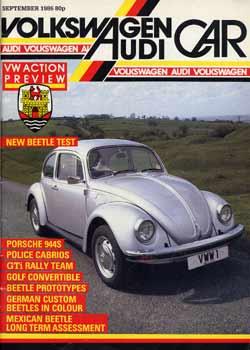
Old Faithful
Full road test of a Last Edition Beetle by Peter Noad.
